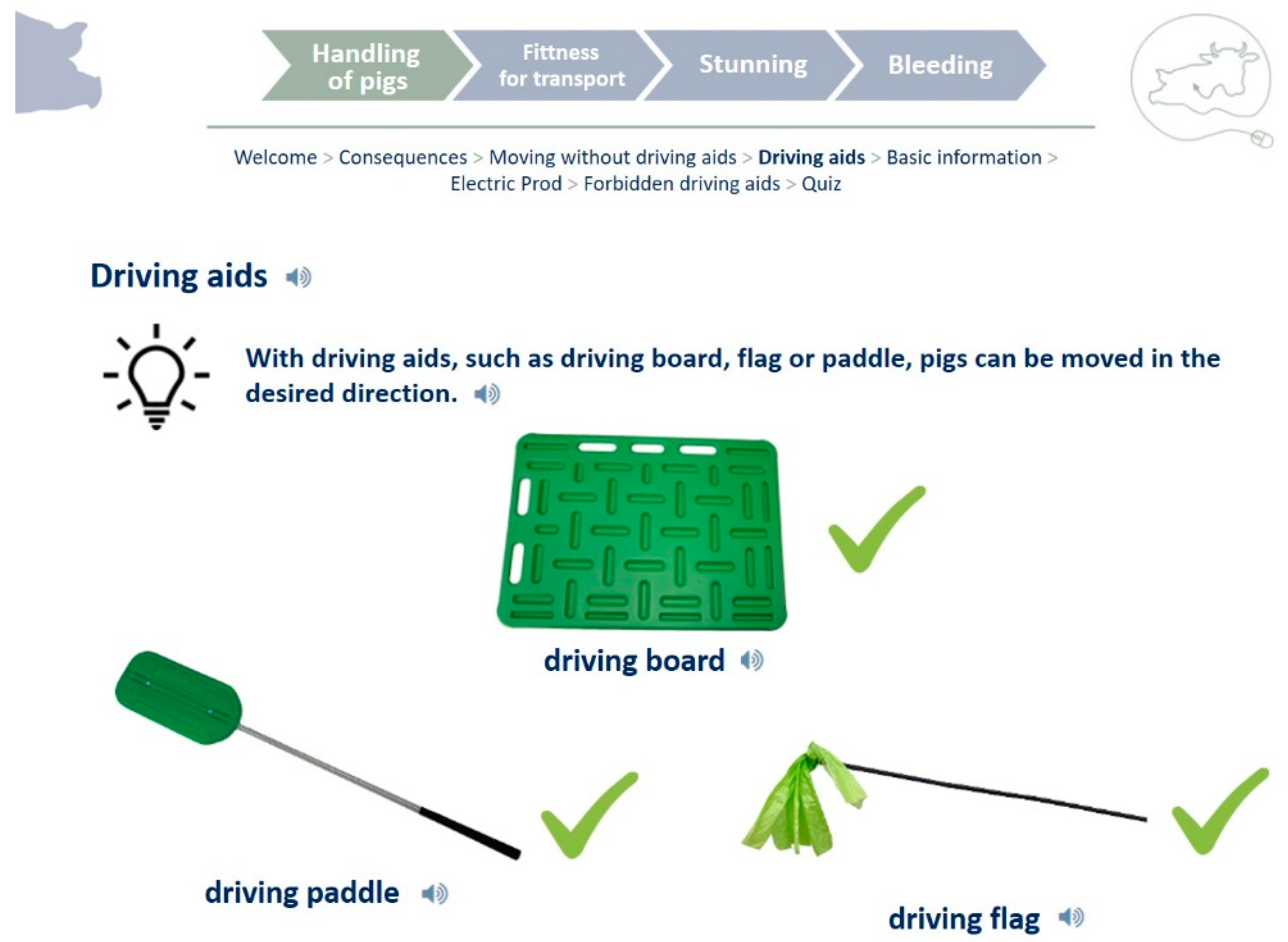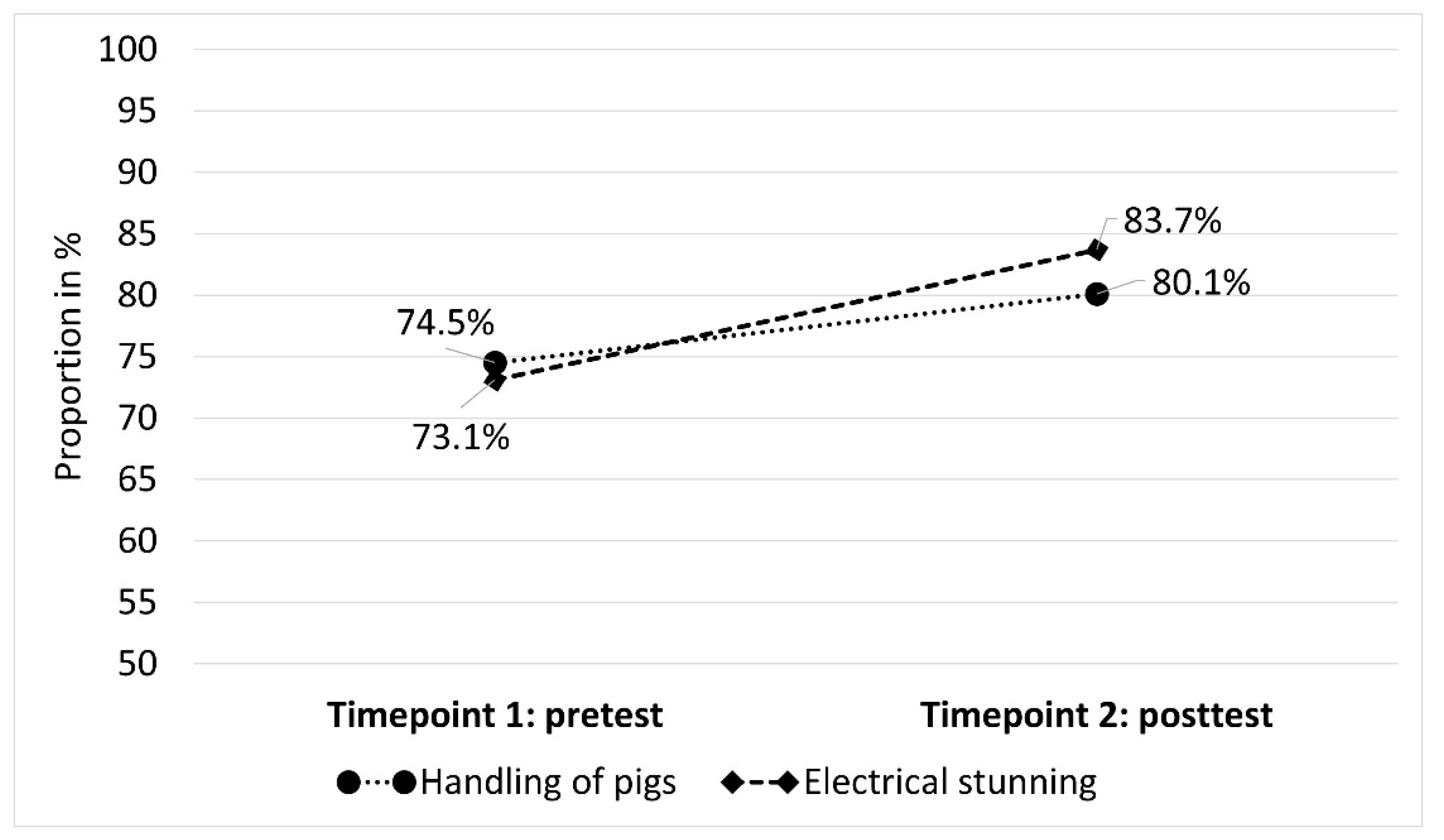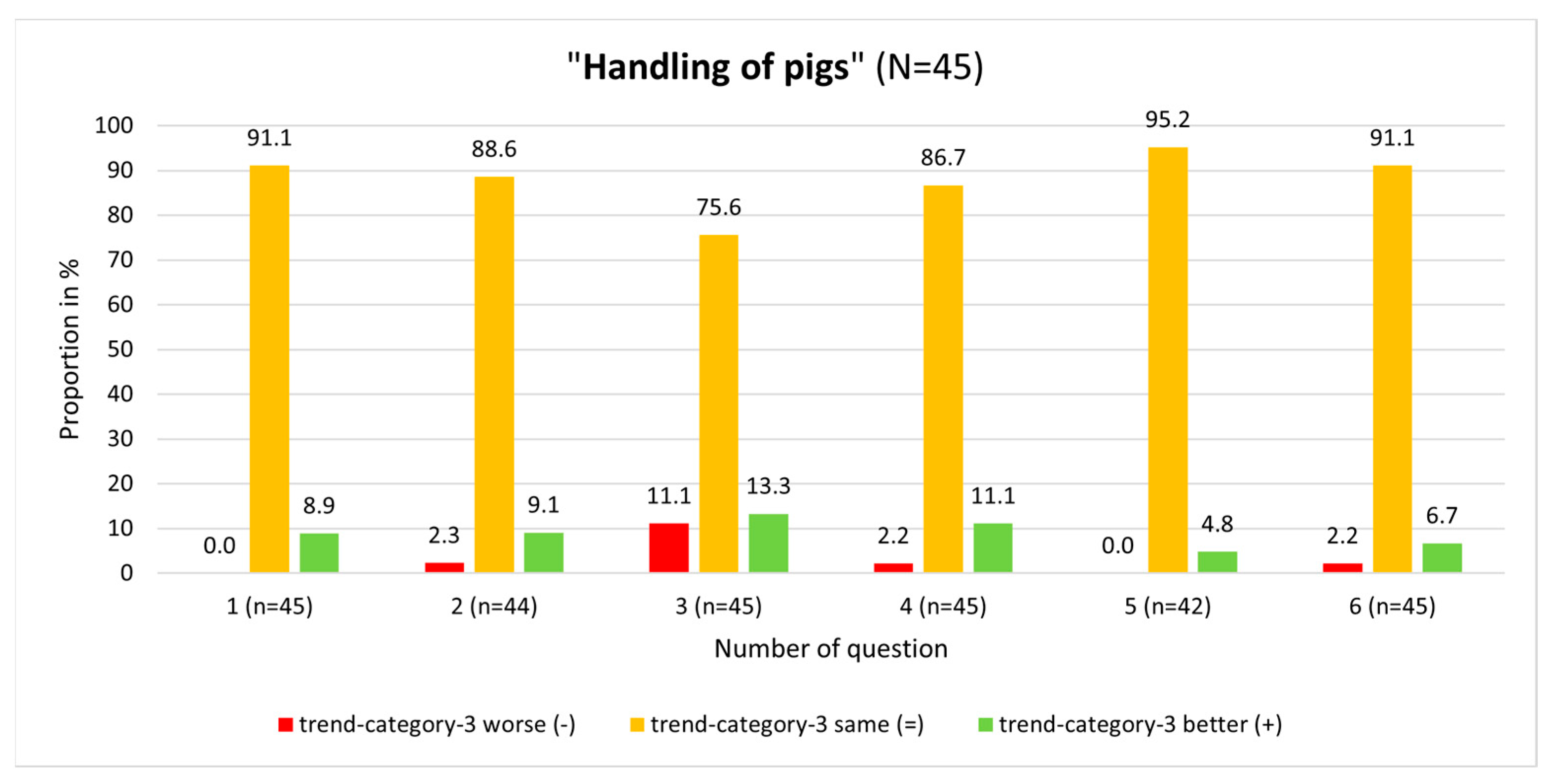Innovative e-Learning Training Modules to Improve Animal Welfare during Transport and Slaughter of Pigs: A Pretest–Posttest Study to Pre-Evaluate the General Didactical Concept
Abstract
:Simple Summary
Abstract
1. Introduction
1.1. Animal Welfare during Transport and Slaughter
1.2. Preliminary Work and Approach to Identify Suitable Training Content
1.3. Didactical Concept for the e-Learning Training Courses
2. Materials and Methods
2.1. Method Used and Participants Included
2.2. Statistical Analysis
3. Results
3.1. Participants
3.2. Overall Knowledge Gain
3.3. Subgroup Analysis: Certificate of Competence, Language Match, Education
3.4. Analysis on Single-Question Level
4. Discussion
4.1. Study Design and General Limitations
4.2. Overall Knowledge Gain
4.3. Subgroup Analysis: Certificate of Competence, Language, Education
4.4. Analysis on Single-Question Level
5. Conclusions
Supplementary Materials
Author Contributions
Funding
Institutional Review Board Statement
Informed Consent Statement
Data Availability Statement
Acknowledgments
Conflicts of Interest
References
- Alonso, M.E.; González-Montaña, J.R.; Lomillos, J.M. Consumers’ Concerns and Perceptions of Farm Animal Welfare. Animals 2020, 10, 385. [Google Scholar] [CrossRef] [PubMed]
- Boivin, X.; Lensink, J.; Tallet, C.; Veissier, I. Stockmanship and Farm Animal Welfare. Anim. Welf. 2003, 12, 479–492. [Google Scholar] [CrossRef]
- TierSchG. Tierschutzgesetz in der Fassung der Bekanntmachung vom 18. Mai 2006 (BGBl. I S. 1206, 1313), das zuletzt durch Artikel 2 Absatz 20 des Gesetzes vom 20. Dezember 2022 (BGBl. I S. 2752) geändert worden ist. 2006. Available online: https://www.gesetze-im-internet.de/tierschg/BJNR012770972.html (accessed on 17 April 2023).
- European Commission. Council Regulation (EC) No 1/2005 of 22 December 2004 on the Protection of Animals during Transport and Related Operations and Amending Directives 64/432/EEC and 93/119/EC and Regulation (EC) No 1255/97. 2005. Available online: https://eur-lex.europa.eu/legal-content/EN/TXT/PDF/?uri=CELEX:32005R0001 (accessed on 24 April 2023).
- TierSchTrV. Verordnung zum Schutz von Tieren beim Transport und zur Durchführung der Verordnung (EG) Nr. 1/2005 des Rates (Tierschutztransportverordnung-TierSchTrV) vom 11. Februar 2009 (BGBl. I S. 375), die zuletzt durch Artikel 9 Absatz 14 des Gesetzes vom 3. Dezember 2015 (BGBl. I S. 2178) geändert worden ist. 2009. Available online: https://www.gesetze-im-internet.de/tierschtrv_2009/ (accessed on 17 April 2023).
- European Commission. Council Regulation (EC) No 1099/2009 of 24 September 2009 on the Protection of Animals at the Time of Killing. 2009. Available online: https://eur-lex.europa.eu/legal-content/EN/TXT/PDF/?uri=CELEX:32009R1099&from=DE (accessed on 17 April 2023).
- TierSchlV. Verordnung zum Schutz von Tieren im Zusammenhang mit der Schlachtung oder Tötung und zur Durchführung der Verordnung (EG) Nr. 1099/2009 des Rates (Tierschutz-Schlachtverordnung-TierSchlV). 2012. Available online: https://www.gesetze-im-internet.de/tierschlv_2013/ (accessed on 17 April 2023).
- Frisch, C.; Merl, K. Tierschutzkontrollen in handwerklichen Schlachtbetrieben. RFL 2019, 71, 338–341. [Google Scholar]
- Anonymous. Handbuch Tierschutzüberwachung bei der Schlachtung und Tötung. AG Tierschutz der Länderarbeitsgemeinschaft Verbraucherschutz (LAV). 2019. Available online: https://www.openagrar.de/servlets/MCRFileNodeServlet/openagrar_derivate_00037082/Handbuch-Tierschutzueberwachung-Schlachten-2019-12-Aktualisierung-2021.pdf (accessed on 17 April 2023).
- European Commission. The Animal Welfare Officer in the European Union. 2012. Available online: https://op.europa.eu/de/publication-detail/-/publication/bb4e4dba-e9ce-4e39-9d51-e3271f069744/language-en (accessed on 25 April 2023).
- Isbrandt, R.; Meemken, D.; Langkabel, N. Animal welfare training at cattle and pig slaughterhouses-Results of an online survey in German-speaking countries. Berl. Münch. Tierärztl. Wochenschr. 2022, 135, 1–16. [Google Scholar]
- Isbrandt, R.; Wiegard, M.; Meemken, D.; Langkabel, N. Impact of Procedures and Human-Animal Interactions during Transport and Slaughter on Animal Welfare of Pigs: A Systematic Literature Review. Animals 2022, 12, 3391. [Google Scholar] [CrossRef] [PubMed]
- Duckwitz, V.; Eichler, F.; Isbrandt, R.; Nicolaisen, S.; Langkabel, N.; Wiegard, M.; Meemken, D.; Thöne-Reineke, C.; Doherr, M. Resultate einer Expert:innenbefragung zur Tierschutzrelevanz einzelner Prozessschritte und deren Verbesserungspotenzial durch Schulungen bei Transport und Schlachtung von Rind und Schwein. In Proceedings of the 22. Fachtagung für Fleisch-und Geflügelfleischhygiene, Berlin, Germany, 1–2 March 2022. [Google Scholar]
- Marsden, E.; Torgerson, C.J. Single group, pre- and post-test research designs: Some methodological concerns. Oxf. Rev. Educ. 2012, 38, 583–616. [Google Scholar] [CrossRef]
- Borg Sapiano, A.; Sammut, R.; Trapani, J. The effectiveness of virtual simulation in improving student nurses' knowledge and performance during patient deterioration: A pre and post test design. Nurse Educ. Today 2018, 62, 128–133. [Google Scholar] [CrossRef] [PubMed]
- Kuraoka, Y. Effect of an experiential learning-based programme to foster competence among nurse managers. J. Nurs. Manag. 2018, 26, 1015–1023. [Google Scholar] [CrossRef] [PubMed]
- Knapp, T.R. Why Is the One-Group Pretest-Posttest Design Still Used? Clin. Nurs. Res. 2016, 25, 467–472. [Google Scholar] [CrossRef] [PubMed]
- Hofmann, E.; Löhle, M. Erfolgreich Lernen: Effiziente Lern-und Arbeitsstrategien für Schule, Studium und Beruf, 3rd ed.; Hogrefe Verlag GmbH & Co. KG: Göttingen, Germany, 2016; pp. 155–156. [Google Scholar]
- Zhan, L.; Guo, D.; Chen, G.; Yang, J. Effects of Repetition Learning on Associative Recognition Over Time: Role of the Hippocampus and Prefrontal Cortex. Front. Hum Neurosci. 2018, 12, 277. [Google Scholar] [CrossRef] [PubMed]
- Payk, T.R. Aufmerksamkeit. Lernen. Gedächtnis. In Psychopathologie: Vom Symptom zur Diagnose, 5th ed.; Springer: Berlin/Heidelberg, Germany, 2021; pp. 243–265. [Google Scholar]
- Wagner, B.; Hassel, A. Posting, subcontracting and low-wage employment in the German meat industry. Transfer 2016, 22, 163–178. [Google Scholar] [CrossRef]
- Flake, R.; Malin, L.; Middendorf, L.; Seyda, S. Lebenssituation und Potenziale An- und Ungelernter. In Berufsbildung für Geringqualifizierte—Barrieren und Erträge; Bundesinstitut für Berufsbildung: Bonn, Germany, 2017; p. 13ff. [Google Scholar]
- Bosch, G.; Hüttenhoff, F.; Weinkopf, C. Fleischwirtschaft. In Kontrolle von Mindestlöhnen; Bosch, G., Hüttenhoff, F., Weinkopf, C., Eds.; Springer: Wiesbaden, Germany, 2019; pp. 191–236. [Google Scholar]
- Smolle, J. Medizinische MC-Fragen: Rasch und Einfach Erstellen, 2nd ed.; Walter de Gruyter GmbH Co. KG: Berlin, Germany; New York, NY, USA, 2010. [Google Scholar]




| n/N % | Trend-Category-3: Individual Knowledge Trends | Mean of Correct Answers in Pretest in % | Mean of Correct Answers in Posttest in % | Mean of Trend (Change from Before to After) in % | |
|---|---|---|---|---|---|
| all participants | 45/45 100.0% |
| 74.5 | 80.1 | +5.6 |
| Certificate of competence | |||||
| yes, hold a certificate of competence | 34/45 75.6% |
| 73.9 | 79.7 | +5.8 |
| no certificate of competence | 11/45 24.4% |
| 79.5 | 84.6 | +5.1 |
| Selection of mother-tongue | |||||
| German possible | 21/45 46.7% |
| 74.5 | 80.1 | +5.6 |
| Romanian possible | 13/45 28.9% |
| 74.1 | 79.0 | +5.0 |
| not possible | 11/45 24.4% |
| 71.0 | 80.6 | +9.6 |
| Education-level | |||||
| secondary school education | 5/43 11.6% |
| 73.8 | 79.6 | +5.8 |
| secondary school education and professional training | 28/43 65.1% |
| 74.5 | 80.1 | +5.6 |
| tertiary education | 10/43 23.3% |
| 75.6 | 82.8 | +7.2 |
| Education-specialization | |||||
| secondary school education | 5/43 11.6% |
| 73.8 | 79.6 | +5.8 |
| secondary school education and professional training in the field or tertiary degree in the field | 13/43 30.2% |
| 73.9 | 79.7 | +5.8 |
| secondary school education and professional training in another field or tertiary degree in another field | 25/43 58.1% |
| 74.3 | 79.7 | +5.4 |
| n/N % | Trend-Category-3: Individual Knowledge Trends | Mean of Correct Answers in Pretest in % | Mean of Correct Answers in Posttest in % | Mean of Trend (Change from Before to After) in % | |
|---|---|---|---|---|---|
| all participants | 46/46 100.0% |
| 73.1 | 83.7 | +10.6 |
| Certificate of competence | |||||
| yes, hold a certificate of competence | 35/46 76.1% |
| 74.0 | 83.3 | +9.3 |
| no certificate of competence | 11/46 23.9% |
| 76.4 | 88.5 | +12.1 |
| Selection of mother-tongue | |||||
| German possible | 21/46 45.7% |
| 73.1 | 83.7 | +10.6 |
| Romanian possible | 14/46 30.4% |
| 73.9 | 83.4 | +9.5 |
| not possible | 11/46 23.9% |
| 78.8 | 86.7 | +7.9 |
| Education-level | |||||
| secondary school education | 5/43 11.6% |
| 76.6 | 85.8 | +9.2 |
| secondary school education and professional training | 28/43 65.1% |
| 73.1 | 83.7 | +10.6 |
| tertiary education | 10/43 23.3% |
| 81.2 | 90.0 | +8.8 |
| Education-specialization | |||||
| secondary school education | 5/43 11.6% |
| 76.6 | 85.8 | +9.2 |
| secondary school education and professional training in the field or tertiary degree in the field | 13/43 30.2% |
| 74.0 | 83.3 | +9.3 |
| secondary school education and professional training in another field or tertiary degree in another field | 25/43 58.1% |
| 74.6 | 84.8 | +10.2 |
| Module “Handling of Pigs” | Module “Electrical Stunning” | |||||
|---|---|---|---|---|---|---|
| n/N % | Test Statistic Value | p-Value | n/N % | Test Statistic Value | p-Value | |
| all participants | 45/45 100.0% | 372.0 | 0.533 | 46/46 100.0% | 322.0 | 0.001 * |
| Certificate of competence | ||||||
| yes, hold a certificate of competence | 34/45 75.6% | 252.0 | 0.683 | 35/46 76.1% | 165.0 | 0.024 * |
| no certificate of competence | 11/45 24.4% | 13.0 | 0.596 | 11/46 23.9% | 28.0 | 0.018 * |
| Selection of mother-tongue | ||||||
| German possible | 21/45 46.7% | 81.0 | 0.226 | 21/46 45.7% | 104.0 | 0.001 * |
| Romanian possible | 13/45 28.9% | 0.0 | 0.002 * | 14/46 30.4% | 12.0 | 0.750 |
| not possible | 11/45 24.4% | 40.0 | 0.036 * | 11/46 23.9% | 23.5 | 0.105 |
| Education-level | ||||||
| secondary school education | 5/43 11.6% | 9.0 | 0.144 | 5/43 11.6% | 6.0 | 0.102 |
| secondary school education and professional training | 28/43 65.1% | 148.5 | 0.483 | 28/43 65.1% | 82.0 | 0.063 |
| tertiary education | 10/43 23.3% | 13.5 | 0.102 | 10/43 23.3% | 28.0 | 0.016 * |
| Education-specialization | ||||||
| secondary school education | 5/43 11.6% | 9.0 | 0.144 | 5/43 11.6% | 6.0 | 0.102 |
| secondary school education and professional training in the field or tertiary degree in the field | 13/43 30.2% | 26.5 | 0.554 | 13/43 30.2% | 6.0 | 0.102 |
| secondary school education and professional training in another field or tertiary degree in another field | 25/43 58.1% | 120.5 | 0.556 | 25/43 58.1% | 148.0 | 0.006 * |
Disclaimer/Publisher’s Note: The statements, opinions and data contained in all publications are solely those of the individual author(s) and contributor(s) and not of MDPI and/or the editor(s). MDPI and/or the editor(s) disclaim responsibility for any injury to people or property resulting from any ideas, methods, instructions or products referred to in the content. |
© 2023 by the authors. Licensee MDPI, Basel, Switzerland. This article is an open access article distributed under the terms and conditions of the Creative Commons Attribution (CC BY) license (https://creativecommons.org/licenses/by/4.0/).
Share and Cite
Isbrandt, R.; Langkabel, N.; Doherr, M.G.; Haase, S.; Meemken, D. Innovative e-Learning Training Modules to Improve Animal Welfare during Transport and Slaughter of Pigs: A Pretest–Posttest Study to Pre-Evaluate the General Didactical Concept. Animals 2023, 13, 3593. https://doi.org/10.3390/ani13233593
Isbrandt R, Langkabel N, Doherr MG, Haase S, Meemken D. Innovative e-Learning Training Modules to Improve Animal Welfare during Transport and Slaughter of Pigs: A Pretest–Posttest Study to Pre-Evaluate the General Didactical Concept. Animals. 2023; 13(23):3593. https://doi.org/10.3390/ani13233593
Chicago/Turabian StyleIsbrandt, Rudi, Nina Langkabel, Marcus G. Doherr, Sebastian Haase, and Diana Meemken. 2023. "Innovative e-Learning Training Modules to Improve Animal Welfare during Transport and Slaughter of Pigs: A Pretest–Posttest Study to Pre-Evaluate the General Didactical Concept" Animals 13, no. 23: 3593. https://doi.org/10.3390/ani13233593
APA StyleIsbrandt, R., Langkabel, N., Doherr, M. G., Haase, S., & Meemken, D. (2023). Innovative e-Learning Training Modules to Improve Animal Welfare during Transport and Slaughter of Pigs: A Pretest–Posttest Study to Pre-Evaluate the General Didactical Concept. Animals, 13(23), 3593. https://doi.org/10.3390/ani13233593






